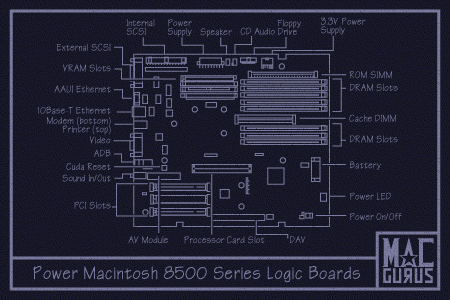


The PowerPC 604-based-Power Mac 8500 boasts a unique logic board (aka "Nitro") in the Power Mac lineup, with eight (8) DRAM DIMM slots and a 64-bit data bus which widens to 128-bits when interleaved. This computer can use 5-volt, 64-bit, 168-pin fast-paged mode (FPM) 70ns DIMMs, with either 2k or 4k refresh, and typically ships with 16MB of RAM (either a single 16MB DIMM in slot B4 or a pair of 8MB DIMMs in slots A4 & B4).This computer can also utilize JEDEC-standard 5-volt EDO DIMMs.
Note: MacGurus reccomends the use of 168-pin, 5v EDO 64-bit, 2k refresh, 60ns DIMMs in this machine. EDO DIMMs are engineered to higher tolerances, and are more compatible with G3 processor upgrades. The two types of RAM can be mixed in a machine.
As there is no DRAM soldered to the logic board, the 8500-series requires that at least one DIMM be installed for the computer to boot. DIMMs may be installed in any slot, in any order, although a performance boost of 10-15% results from installing matching pairs of high-quality DIMMs in pairs, in corresponding slots (A4-B4, A3-B3, A2-B2, A1-B1), as a consequence of interleaving. Apple specs state that the maximum amount of usable memory is 512MB, in the form of eight (8) 64MB DIMMs, although other configurations are theoretically conceivable through the use of 128MB DIMMs.
Like other Power Macs of its generation, the 8500-series does not require DIMMs to be installed in pairs. In contrast to the 7200-series, however, the 8500's HammerHead ASIC memory controller does support memory interleaving, utilizing a 128-bit memory path. When purchasing memory for this computer, consequently, it is best to purchase DIMMs in matching pairs, to ensure that chipsets, density, and speed, all correspond. Disparate pieces may interleave, especially if they are of high quality and well within Apple specifications, but chances are enhanced if differences between DIMMs are minimized.
One of the strengths of the 8500-series architecture is that it accepts L2 cache DIMMs in capacities of 256k, 512k, or 1MB, in contrast to the 9500 Tsunami motherboard, which is limited to the 512k L2 cache soldered on the logic board.
The 8500-series also boasts fast 64-bit video circuitry which enables both video capture and printing to video tape, as well as support for simultaneous use of NTSC/PAL monitors off the computer's RCA or S-Video jacks.
NTSC/PAL monitors can be used at the same time as the computer's main display (by definition the one attached to the logic board video port, although like other Power Macs, the 8500 can drive additional displays off third party PCI video cards, for a contiguous desktop of extended size) through the addition of two standard 112-pin 70ns VRAM DIMMs to its stock configuration. The 8500 typically ships with two (2) of its four (4) VRAM slots filled.
Details can be found in articles Power Mac 8500, 8600 Unable to Display Video On TV (TECHINFO-0018559), and Power Mac 7500 8500 Max Color (TECHINFO-0018358) in the Apple Technical Information Library (TIL).
Specifications Logic Board RAM None Supported DIMMs 32MB, 64MB, 128MB Number DIMM Slots Eight (8) Supported VRAM 112-pin 70ns VRAM DIMM: 1024k Number VRAM Slots Four (4) L2 Cache Supported L2 DIMM: 256k, 512k, 1MB DIMM Type 168-pin, 5v EDO 64-bit, 2k refresh, 60ns.
As noted, the 8500-series have four (4) 1MB VRAM DIMM slots on the logic board, and typically ship with two (2) slots filled. When two additional 1MB VRAM DIMMs are installed, the maximum capacity of 4MBs on-board VRAM is achieved.